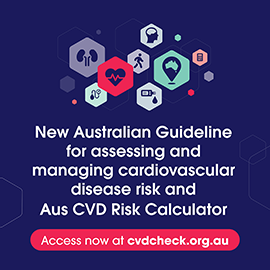Guideline for assessing and managing cardiovascular disease risk
The 2023 Australian Guideline for assessing and managing cardiovascular disease risk and associated Australian cardiovascular disease risk calculator (Aus CVD Risk Calculator) brings together the latest evidence distilled from multidisciplinary clinical and consumer groups to inform guideline recommendations for the assessment and management of CVD risk.
The development of the guideline and calculator was led by the Heart Foundation on behalf of the Australian Chronic Disease Prevention Alliance (ACDPA), represented in this project by Diabetes Australia, Kidney Health Australia and Stroke Foundation.
One of the notable advancements in this guideline is that, for the first time, Australia will have a CVD risk prediction equation uniquely modified and recalibrated for the Australian population to enable more accurate risk estimation.
The guideline enables assessment and early identification of CVD risk in people aged 45 years to 79 years without known CVD (from 30 years for First Nations people and from 35 years for people with diabetes). With redefined risk categories, the guideline helps clinicians direct management strategies and pharmacotherapy to those who will benefit the most. Recognising the significance of effective communication, the calculator interface, with built-in patient decision support tools, supports shared decision-making between health professionals and patients.
Endorsed by the Royal Australian College of General Practitioners (RACGP), the 2023 Australian Guideline for assessing and managing cardiovascular disease risk sets the new standard for CVD prevention in primary care in Australia and is a major achievement for our health system.
Guidelines and tools
Australian Guideline for assessing and managing cardiovascular disease risk



